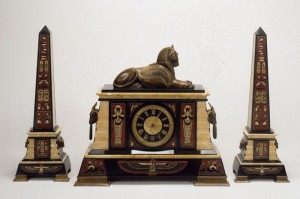Shadow of the Sphinx: Ancient Egypt and Its Influence in the 19th and 20th Centuries
Anna Tobin D'Ambrosio, Munson-Williams-Proctor Arts Institute

Mantel Garniture, ca.1875-1885 Maker: Unknown, French Retailer: Tiffany & Company, American, New York, NY (active 1837-present) Slate, marble, bronze, brass, wood, and glass Clock: 18-1/2 x 21 x 7-3/4 inches Obelisks: 20-1/2 x 7-3/4 x 5-1/8 inches Munson-Williams-Proctor Arts Institute, Museum of Art, Utica, New York

Watch, ca. 1880-1900 Probably Swiss Gold, enamel, diamonds, emeralds, steel, and rubies 2 1/4 × 1 1/4 × 5/16 inches Munson-Williams-Proctor Arts Institute, Museum of Art, Utica, New York

Pair of Vases, ca. 1875-1900 France Porcelain Courtesy of Hirschl and Adler Galleries, New York, New York
Anna D’Ambrosio invites us to travel through the eternally fascinating world of Egypt with her and to witness Egypt’s long influence in arts and culture into the present. Since the dawn of recorded time, no nation has mesmerized and influenced the world quite like ancient Egypt. Ancient Egypt has the whole package - incredible wealth and beautiful objects, great stories of powerful people, awe-inspiring deities, mystery, discovery and, of course, the promise of eternal life.
For more than a century, Egyptian-inspired artworks have illustrated an obsession with a culture far removed from most people’s everyday lives. Ms D’Ambrosio will explore the allure of ancient Egypt and its astounding influence on European and American artists and designers from the mid-19th century through the early 20th century. Landmarks along the way of this adventure include Egyptian-inspired furniture motifs by French-born Anthony Quervelle (1789–1865) who plied his craft in Philadelphia and the New York firm of Pottier & Stymus (founded in 1859). Louis C. Tiffany and Cartier designed opulent jewelry in the Egyptian taste.
Specific events have periodically ignited, and re-ignited, America’s and Europe’s fascination with the rich and exotic history of ancient Egypt. A frenzy for Egyptian-inspired style followed English Admiral Horatio Nelson’s victory over the French at the Battle of the Nile in 1798. When Frenchman Jean-Francois Champollion broke the code of the Rosetta Stone in 1822, he made a major contribution to the understanding of hieroglyphics and other ancient languages and sparked another craze for things Egyptian.
Publication of The Description of Egypt *between 1809 and 1828 and Owen Jones’ *Grammar of Ornament in 1856 provided inspiration to generations of designers with a stylistic vocabulary of motifs, geometric patterns and a color palette. The 1869 opening of the Suez Canal opened a new, major trade route and prompted a new popularity in Egyptian subject matter.
By 1876, when millions of Americans visited the Egyptian display at the Centennial Exhibition in Philadelphia, Egyptian decorative vocabulary was ubiquitous. Raising obelisks, “Cleopatra’s Needles,” in London (1878) and New York (1881) carried the momentum. The most recent incarnation of Egyptomania took place in the years after Lord Carnarvon (whose ancestral home now serves as the set for Downton Abbey) and Howard Carter revealed the wonders of King Tutankhamun’s tomb in 1922.
Ms D’Ambrosio will conclude with the transporting fantasies of Egypt in popular culture. Ancient Egypt’s allure continues to captivate our imaginations through songs, movies and everyday objects. Apart from the glamor and romanticism associated with ancient Egypt, we must understand Egypt in order to understand the history of human civilization. Anna D’Ambrosio last spoke to the Forum about “A Brass Menagerie: Metalwork of the Aesthetic Movement” in 2007.